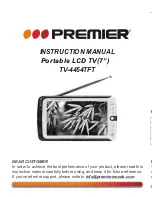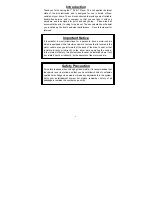
DYNA SERIES 5/97
Page 8
60707-110
OPERATOR CARE AND MAINTENANCE
slight variation in speed also affects the frequency of the
output current. This frequency variation has no appreciable
effect in the operation of motors, lights and most appliances.
However, electronic equipment and clocks will be affected if
correct RPM is not maintained. See Load vs. Output chart.
Although individual units and models may vary slightly, the
normal voltage and frequency of the engine-generators
described in this book are approximately as follows, under
varying loads:
LOAD vs. OUTPUT
__________________________________________________________________________________________________________________
Generator Frequency
Voltage
Load
Speed
120V
Applied*
(RPM)
(Hz)
Recpt.
__________________________________________________________________________________________________________________
None
3750
62.5
129V
Half
3600
60.0
120V
Full
3540
59.0
115V
__________________________________________________________________________________________________________________
*Portion of plant’s rated output current.
The speed of the engine was carefully adjusted at the factory
so that the generator produces the proper voltage and
frequency. For normal usage, the speed setting should not
be changed. If the generator is being run continuously on a
very light load, it is often advisable to lower the operating
speed slightly. Whenever making any speed adjustments
check the unit with a voltmeter or tachometer and be sure the
speed is correct.
Lower voltage may damage both the generator and any load
connected to it. Running the engine at excessively high
speeds results in high voltage, which may significantly
shorten the life of appliances being used.
Output voltage should be checked periodically to ensure
continued proper operation of the generating plant and
appliances. If the generator is not equipped with a voltmeter,
it can be checked with a portable meter. Frequency can be
checked by using an electric clock with a sweep second
hand. Timed against a wrist watch or a stop watch the clock
should be correct /- 2 seconds per minute.
CONNECTING THE LOADS
Applying The Load
Allow the engine to warm up for two or three minutes before
applying any load. This will allow the engine to reach normal
operating temperature and oil to circulate throughout the
engine. A short warm-up time will permit the engine to work
more efficiently when the load is applied and will reduce the
wear in the engine, extending its life.
Receptacles have been provided to allow loads to be
connected to the generator. The loads should be added one
at a time. If a large motor is being started or multiple motors
are being started, they should be started individually and the
largest should be started first.
CAUTION: EQUIPMENT OVERLOAD
Keep the generator load within the generator and
receptacle nameplate rating. Overloading may cause
damage to the generator and/or the loads .
Most electric tools and appliances will have the voltage and
amperage requirements on their individual nameplates.
When in doubt consult the manufacturer or a local
electrician. The nameplate amperage rating for electric
motors can be misleading. See “Starting Electric Motors” in
Unit Capabilities (page 3).
These engine generator sets are inherently self regulating
based on engine speed. The engine governor will
automatically adjust itself to the load. No harm to the
generator will result if it is operated with no load connected.
Proper utilization of the receptacles located on the control
panel is necessary to prevent damage to either the
receptacles or the generator. The generator is a limited
source of electrical power, therefore pay special attention to
the receptacle and generator ratings. The nameplate rating
can be obtained through a single receptacle as long as the
receptacle amperage rating is not exceeded.
Grounding
All units must be grounded. Drive a 3/4 or 1" copper pipe
or rod into the ground close to the engine-generator set.
The pipe must penetrate moist earth. Connect an
approved ground clamp, to the pipe. Run a no. 10 Awg wire
from clamp to the generator ground lug on the “end cover”.
Do not connect to a water pipe or to a ground used by a
radio system.
The engine-generators covered in this manual were
designed for portable use. Do NOT install or operate this
generator indoors. The unit should be stored in a warm dry
location. During a power outage, move the unit outdoors to
a flat dry location such as a driveway or sidewalk.
Many homes today are wired for at least 60 to 100 Amp
entrance service, much greater than the capacity of these
portable generators. Do not attempt to power a home with
this portable generator. This generator set is suitable for
powering individual appliances or emergency lighting.
ENGINE CARE
If major engine service or repair is required contact an
authorized engine service center. The manufacturer of
these engines has established an excellent world-wide
engine service organization. Engine service is very likely
available from a nearby authorized dealer or distributor.
Check the yellow pages of your local telephone directory
under “Engines-Gasoline” for the closest engine repair
center or ask the dealer from whom you purchased the
power plant.
1. Change the oil after the first five hours of operation
and every 50 hours thereafter under normal
operating conditions. Change engine oil every 25
hours of operation if the engine is operated under
heavy load, or in high ambient temperatures.
a. Remove oil drain plug at base of the engine
and drain the oil with the engine warm.
b. Replace oil drain plug.
c. Remove oil filler plug and refill with new oil.
Refer to the table in the engine manual for the
proper grade of oil based on your operating
temperature.
d. Replace filler plug.






























